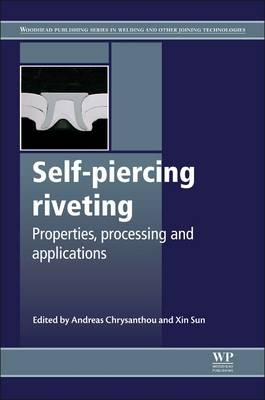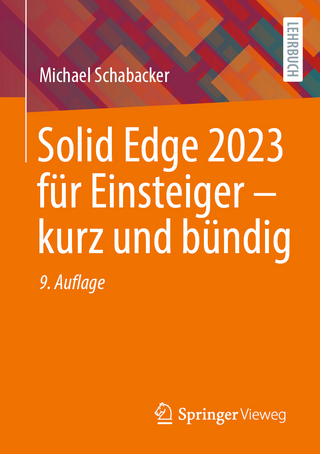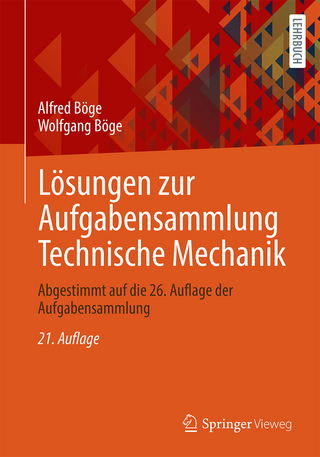
Self-Piercing Riveting
Woodhead Publishing Ltd (Verlag)
978-1-84569-535-4 (ISBN)
- Titel ist leider vergriffen;
keine Neuauflage - Artikel merken
Due to its speed, low energy requirements, and the fact that it does not require a pre-drilled hole, the technique of self-piercing riveting (SPR) has been increasingly adopted by many industries as a high-speed mechanical fastening technique for the joining of sheet material components. Self-piercing riveting comprehensively reviews the process, equipment, and corrosion behaviour of self-piercing riveting, and also describes the process of evaluation and modelling of strength of self-piercing riveted joints, quality control methods and non-destructive testing.
Part one provides an extensive overview of the properties of self-piercing riveting. Chapters in this section review the mechanical strength, fatigue, and corrosion behaviour of self-piercing riveted joints. The second part of the book outlines the processing and applications of SPRs, and describes the dynamic strength evaluation/crashworthiness of SPRs, and the modelling of strength of self-piercing riveted joints, before going on to discuss the assessment of the suitability of materials for self-piercing riveting. The concluding chapters describe the quality control and non-destructive testing of self-piercing riveted joints, optimization of the strength of self-piercing rivets, and provides an overview of self-piercing rivets in the automotive industry and the applications of self-piercing riveting in automated vehicle construction.
Self-piercing riveting is a standard reference for engineers and designers in the aerospace, materials, welding, joining, automotive and white goods industries, as well as manufacturers of metal components for the automotive, aerospace, white goods and building industries.
Professor Andreas Chrysanthou is a Reader in Materials Engineering at the School of Engineering and Technology at the University of Hertfordshire, UK. Dr Xin Sun is a Computational Scientist and Laboratory Fellow at Pacific Northwest National Laboratory, USA.
Contributor contact details
Woodhead Publishing Series in Welding and Other Joining Technologies
1. Introduction
Abstract
1.1 Introduction
1.2 Self-piercing riveting (SPR)
1.3 Advantages and possible disadvantages of the SPR process
1.4 Application of SPR in automotive body applications
1.5 Future trends
Part I: Properties
2. Mechanical strength of self-piercing riveting (SPR)
Abstract
2.1 Introduction
2.2 Test types and their relevance
2.3 Failure mechanisms
2.4 Rivet strength optimization
2.5 Self-piercing riveting (SPR) and structural adhesive joining
3. Fatigue behaviour of self-piercing riveted joints
Abstract
3.1 Introduction
3.2 Comparison between self-piercing riveted and resistance spot-welded joints
3.3 Factors that affect the fatigue behaviour of self-piercing riveted joints
3.4 Fretting fatigue
4. Corrosion behaviour of self-piercing riveted joints
Abstract
4.1 Introduction
4.2 Background theory of corrosion
4.3 Methodology of corrosion studies
4.4 Corrosion of self-piercing riveted joints
4.5 Corrosion protection of self-piercing rivets and joints
5. Dynamic strength evaluation/crashworthiness of self-piercing riveted joints
Abstract
5.1 Introduction
5.2 State-of-the-art review of dynamic tensile tests
5.3 Recommended joint dynamic strength testing procedures
5.4 Results and discussion
5.5 Conclusions
6. Modelling the strength of self-piercing riveted joints
Abstract
6.1 Introduction
6.2 Mechanical strength of a self-piercing riveting (SPR) structure
6.3 Mechanical behaviour and damage analysis
6.4 Numerical modelling
6.5 Conclusions and future trends
Part II: Processing and applications
7. Assessing the suitability of materials for self-piercing riveting (SPR)
Abstract
7.1 Introduction
7.2 How self-piercing riveting (SPR) joins materials
7.3 Joining of similar metals
7.4 Joining of dissimilar metals
7.5 Finite element simulations of the riveting process
7.6 Future trends
8. Quality control and non-destructive testing of self-piercing riveted joints
Abstract
8.1 Introduction
8.2 Current technologies
8.3 Non-destructive testing (NDT) techniques: computer vision
8.4 NDT techniques: ultrasonic testing
8.5 Conclusions
9. Optimization of the strength of self-piercing rivets (SPRs)
Abstract
9.1 Introduction
9.2 Rivet strength estimation
9.3 Rivet strength optimization
9.4 Conclusions
10. Self-piercing riveting (SPR) in the automotive industry: an overview
Abstract
10.1 Introduction
10.2 Types of self-piercing rivet (SPR)
10.3 Uses for SPRs
10.4 Product considerations
10.5 Manufacturing considerations
10.6 Future trends
11. Self-piercing riveting (SPR) in automated vehicle construction
Abstract
11.1 Introduction
11.2 Material requirements
11.3 Joining techniques
11.4 Evaluation of processes
11.5 Cost comparisons
11.6 Comparable joint performance
11.7 Specific process opportunities
11.8 Process development
11.9 Industrial application
11.10 Conclusions
11.11 Acknowledgements
Index
| Erscheint lt. Verlag | 4.12.2013 |
|---|---|
| Reihe/Serie | Woodhead Publishing Series in Welding and Other Joining Technologies |
| Verlagsort | Cambridge |
| Sprache | englisch |
| Maße | 156 x 234 mm |
| Gewicht | 490 g |
| Themenwelt | Technik ► Maschinenbau |
| ISBN-10 | 1-84569-535-6 / 1845695356 |
| ISBN-13 | 978-1-84569-535-4 / 9781845695354 |
| Zustand | Neuware |
| Informationen gemäß Produktsicherheitsverordnung (GPSR) | |
| Haben Sie eine Frage zum Produkt? |
aus dem Bereich


